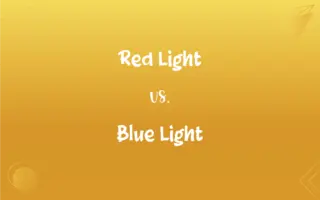Mirror vs. Lens: What's the Difference?
Edited by Aimie Carlson || By Harlon Moss || Updated on October 13, 2023
A mirror reflects light to form an image, while a lens refracts light to focus or disperse it.

Key Differences
A mirror is a surface that reflects light in such a way as to produce an image. It can be flat, concave, or convex in shape. On the other hand, a lens is a piece of transparent material, like glass or plastic, that has at least one curved surface and refracts, or bends, light rays that pass through it.
Mirrors work on the principle of reflection. When light rays hit the mirror's surface, they bounce back, allowing us to see an image. Lenses operate on the principle of refraction. As light enters a lens, it changes direction due to the curvature of the lens, which can cause images to appear magnified, reduced, or otherwise altered.
In terms of applications, mirrors are commonly used for viewing one's reflection, in telescopes, and in various optical instruments. Lenses, on the other hand, have a broader range of applications including in eyeglasses, cameras, microscopes, and telescopes.
A mirror's primary function is to produce a reflection. The kind of reflection (virtual or real, upright or inverted) depends on the mirror's shape. Lenses, in contrast, either converge or diverge light rays, leading to varied image formations based on the lens type (concave or convex).
While mirrors predominantly deal with reflection, avoiding the passage of light through them, lenses allow light to pass through, bending it in the process to produce an effect on the perceived image.
ADVERTISEMENT
Comparison Chart
Function
Reflects light.
Refracts (bends) light.
Principle
Reflection.
Refraction.
Image Formation
Based on reflection type (virtual/real).
Based on lens type (converging/diverging).
Applications
Viewing, telescopes, optical instruments.
Eyeglasses, cameras, microscopes, telescopes.
Material Passage
Blocks light, reflecting it.
Allows light through, bending it.
ADVERTISEMENT
Mirror and Lens Definitions
Mirror
A surface reflecting light to produce an image.
She checked her hairstyle in the mirror.
Lens
A piece of glass or plastic shaped for use in eyeglasses.
Her new glasses had a corrective lens.
Mirror
An object that offers a reflection of another.
The lake was a perfect mirror of the sky.
Lens
A medium through which something is seen or analyzed.
He viewed the event through the lens of his past experiences.
Mirror
A model or pattern for imitation.
She was the mirror of grace and poise.
Lens
The light-gathering device in a camera.
She invested in a high-quality lens for her photography.
Mirror
A device that reflects light for optical use.
The telescope's mirror focused on the distant star.
Lens
An optical device forming a focused image.
The microscope lens revealed minute details.
Mirror
Something that gives a true representation.
His actions were a mirror of his words.
Lens
A curved piece of transparent material that refracts light.
He adjusted the camera lens to capture the scene.
Mirror
A surface capable of reflecting sufficient undiffused light to form an image of an object placed in front of it. Also called looking glass.
Lens
A ground or molded piece of glass, plastic, or other transparent material with opposite surfaces either or both of which are curved, by means of which light rays are refracted so that they converge or diverge to form an image.
Mirror
Something that faithfully reflects or gives a true picture of something else.
Lens
A combination of two or more such pieces, sometimes with other optical devices such as prisms, used to form an image for viewing or photographing.Also called compound lens.
FAQs
Are mirrors always made of glass?
Primarily, but they can also be made of polished metal or other reflective materials.
What is a mirror's primary function?
A mirror reflects light to produce an image.
How does a lens function differently from a mirror?
A lens refracts or bends light, altering its path.
Can a mirror magnify objects?
A concave mirror can magnify objects when they are close to it.
How do camera lenses work?
Camera lenses gather and focus light onto a sensor or film to capture an image.
What does a plane mirror produce?
A plane mirror produces a virtual, upright, and same-sized image.
How do mirrors create virtual images?
Mirrors create virtual images when light rays appear to come from a location behind the mirror.
Can mirrors and lenses be combined in optical devices?
Yes, telescopes often use both mirrors and lenses for image magnification and clarity.
Why are lenses crucial in microscopes?
Lenses in microscopes magnify tiny objects by refracting light to produce a larger image.
Are lenses always made of glass?
No, lenses can also be made of plastic or other transparent materials.
How do curved mirrors differ from flat mirrors?
Curved mirrors (concave/convex) can magnify, reduce, or invert images, while flat mirrors produce same-sized reflections.
What's the function of a lens in a projector?
In a projector, a lens focuses light to project a magnified image onto a screen.
How are lenses graded for vision correction?
Lenses are graded based on their optical power and ability to converge or diverge light.
What's a convex lens used for?
A convex lens converges light rays, often used in magnifying glasses or to correct farsightedness.
What is a concave lens used for?
A concave lens diverges light rays, often used to correct nearsightedness.
How are mirrors used in telescopes?
Mirrors in telescopes gather and focus light to produce a magnified image of distant objects.
Can mirrors and lenses both invert images?
Yes, certain configurations of mirrors and lenses can produce inverted images.
What is the purpose of a lens in eyeglasses?
A lens in eyeglasses corrects vision by refracting light to focus correctly on the retina.
What's the "silvering" process in mirror-making?
"Silvering" refers to applying a reflective coating, like aluminum or silver, on the back of clear glass to create a mirror.
Why is the quality of a camera lens essential for photographers?
The quality of a camera lens affects image clarity, sharpness, and the ability to capture fine details.
About Author
Written by
Harlon MossHarlon is a seasoned quality moderator and accomplished content writer for Difference Wiki. An alumnus of the prestigious University of California, he earned his degree in Computer Science. Leveraging his academic background, Harlon brings a meticulous and informed perspective to his work, ensuring content accuracy and excellence.
Edited by
Aimie CarlsonAimie Carlson, holding a master's degree in English literature, is a fervent English language enthusiast. She lends her writing talents to Difference Wiki, a prominent website that specializes in comparisons, offering readers insightful analyses that both captivate and inform.































































